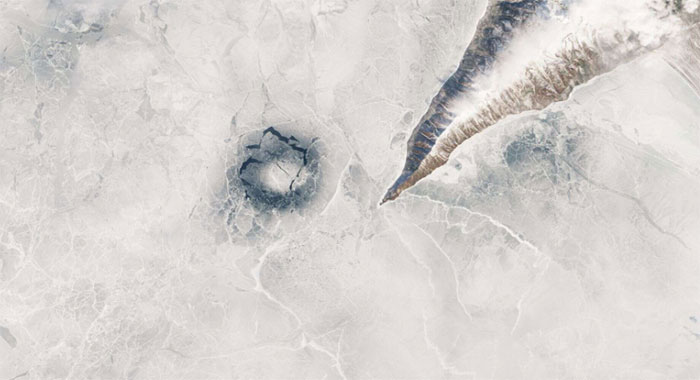Mysterious ice rings in the deepest lake in the world
Mysterious "ice rings" highlight the deepest lake in the world during the winter and spring months of Siberia.
Although they look like icy circles, they are not due to alien activity, or as previously thought due to the methane bubbles flooding from the bottom of the lake.

Image of an ice ring in Lake Baikal.
Instead, it appears oddly beneath the thick ice of Lake Baikal. Some of them are more than 6 km in diameter and can be seen from space.
Solving this mystery is not an easy task. An international team of researchers from France, Russia and Mongolia chose to travel to the lake in 2016 and 2017, drilled holes in ice near the circles and dropped the sensors into the water below.
During the colder months of Siberia, Lake Baikal - the largest freshwater lake in the world , by volume, freezes.
'The ice is so thick, people often drive through it,' said lead researcher Alexei Kouraev, assistant professor at the Geophysical and Oceanographic Research Laboratory (LEGOS) at Federal University in France. know.
In addition to the thick ice on the outside and on the inside, thin bands of 'rings' that could put vehicles and occupants at risk, Kouraev said.
Known bands of ice have formed on Lake Baikal since at least 1969 and can exist anywhere from a few days to a few months, satellite images show. However, ice rings like these rings appear unpredictable, and appear in different parts of the lake from year to year. Furthermore, basil tends to appear in late April and may grow as early as January or as late as May.
So far scientists have not been able to figure out how they were formed. One of the most interesting theories is that there is a connection with the bubbling methane gas from the deep lake bed causing these ice rings. But Kouraev and his colleagues found that some of these ice sheets formed in the shallower waters of the lake, areas without emissions.
After analyzing data from the sensors they dropped into the lake, the scientists discovered that the lake had warm water clockwise flowing under its ice. The flow is not strong at the center, which may explain why the centers of these glaciers still have thick ice. However, the edges are very strong, which explains why the ice on top is thinner.
Sensors revealed that the water in these areas is 1 to 2 degrees warmer than the surrounding water. Moreover, the ice rings are shaped like lenses, a common phenomenon in the oceans but rare in lakes.
According to the sensors held under water for 1.5 months at the same time, as well as the infrared image of the thermal sensor, it seems that the ice rings form each fall , before the lake freezes. Moreover, strong winds blowing in the waters from the nearby Barguzin Bay can help them form.
Kouraev noted that so far these ice bands have only been found in Lake Baikal, as well as nearby Hovsgol Lake in Mongolia and Lake Teletskoye in Russia.
- Decipher the mysterious circle in Antarctica
- The mysterious circle on the field has not been answered yet
- Mysterious legend in the world's deepest freshwater lake
- Algae invade the deepest lake in the world
- Russians conquer the deepest lake in the world
- 4 most mysterious lakes in the world: The dreamy poetic, where it contains hundreds of human skeletons
- The mystery of 130 massive dead seals in the world's deepest lake
- The deepest lake fish in Africa is increasingly scarce
- Wedding rings in the ancient world
- Mysterious about Lake Baikal - The largest lake in the world
- Discover groove secrets Mariana
- The ancient 'city' mystery at the bottom of the lake no one knows for thousands of years
- Russia: Discovering new creatures in Lake Baikal
- How does the 'hell well' deepest on the ground appear?
 The truth about the mysterious red-haired giant at Lovelock Cave
The truth about the mysterious red-haired giant at Lovelock Cave Inunaki Tunnel: The haunted road leading into Japan's 'village of death'
Inunaki Tunnel: The haunted road leading into Japan's 'village of death' The mystery of the phenomenon of human reflection before dying
The mystery of the phenomenon of human reflection before dying 6 mysterious phenomena, although science has been developed for a long time, still cannot be answered
6 mysterious phenomena, although science has been developed for a long time, still cannot be answered